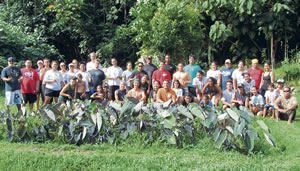Growing Kalo To Save Our Reefs

Members of Papahana Kuaola in the lo‘i. Photo courtesy Matt Schirman
Who would have thought growing taro could help protect our precious reefs and ocean environment? Ancient Hawaiians knew it could, and more of us are learning about the benefits of such efforts today.
It’s happening in Kaneohe, where a grassroots project aimed at improving near shore water conditions in Kaneohe Bay is moving full “stream” ahead.
For the past month, members from the local Oahu nonprofit group Papahana Kuaola have been working hard to create a Hawaiian lo’i (irrigation) system to secure, collect and disperse runoff from Heeia Stream in Ko’olaupoko. Besides improving conditions in the bay, the organization hopes to engage community members in stewardship activities promoting sustainability.
“Our organization uses native Hawaiian plants for lo’i restoration,” says Matt Schirman, director of Papahana Kuaola’s ‘Ili’ilikauhale program. “We want to impact the ocean directly, which ultimately helps our reefs. We saw what happened after the storms hit a couple of weeks ago; Kaneohe Bay was one big mess! Better land management can control erosion that occurs.”
Brown water runoff is an issue Kaneohe Bay residents are all too familiar with, especially after heavy rains. ‘Ili’ilikauhale is an on-site education program that is creating a 10,000-square-foot sediment basin and lo’i complex.
Volunteers have been working tirelessly to remove alien species, while planting native plants along the stream. The effort also is requiring some heavy construction, which includes removal of larger invasive trees, hauling materials and digging out sediment from the basin.
The goal is to catch sediment and promote the strengths of an ahupua’a ecosystem.
“Picture it like a big swimming pool slowing the water down,” explains Schirman of the retention basin. “The sediment sits at the bottom of the pool and the water flows off the basin and into our lo’i system. The finer sediment is caught in the final filtration and the remaining water flows down into the stream.”
Less sediment and soil contaminants flowing into the ocean means less damage to our reefs and marine life.
“We are taking an area that sees its share of flash floods and landslides and filtering out the soil,” Schirman says proudly. “We are keeping the soil on the land as opposed to flooding our precious reefs.”
The project is one of six throughout Hawaii aimed at the restoration and stewardship of coastal habitat that received a portion of a $268,550 grant from the Hawai’i Community Foundation. Funding for these projects is made possible through a three-year partnership among HCF, the National Oceanic and Atmospheric Administration’s (NOAA) Restoration Center and the Harold K.L. Castle Foundation.
The ‘Ili’ilikauhale program hopes to engage up to 720 community members to foster environmental stewardship during the project. Schirman says the project should be completed in about two years. When done, they hope to have a fully functional and operational, four-acre lo’i.
“This project goes along with every movement in Hawaii these days, better health of our ocean by stopping the pollutants and erosion from emptying into the precious resource,” he says. “It also addresses the issue of sustainability.”
Papahana Kuaola surfaced five years ago. Its mission is to create quality educational programs focused on Hawaii’s cultural and natural history, environmental restoration and economic sustainability.
“An estimated 18,000 community members take part in our projects every year both educational groups as well as service-oriented projects,” says Schirman.”We’re not just having an impact on our project, we’re also helping in different areas. And hopefully this will promote the support of other projects in the community in the future. Absolutely, we could always use more volunteers, the more the better!”
For more information on the project and how your group could be a part of it all, email leaders at papaku66@gmail.com.



